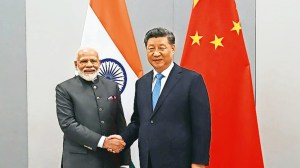Kargil Ten years on
A decade after India lost 533 soldiers and officers in the Kargil war,the number of troops on these peaks has gone up nearly five times. Manu Pubby looks at all that has changed on this side of the border. <b>Photographs: Tashi Tobgyal</b>...
A decade after they boomed non-stop to evict Pakistani intruders from the heights of Drass and Kargil,the Armys Bofors artillery guns lie silent in Apatti,a small village that overlooks the strategic town of Kargil.
Located on a gentle slope that can easily find a place in any tourism magazine,the guns have not fired since 2003,when a ceasefire agreement was reached between India and Pakistan. However,the deceptive calmness is broken as men and officers constantly calibrate and feed the destructive machines with the latest positions that the enemy has taken up across the border. The closest being a mere seven kilometres away.
All along the Line of Control in the Batalik-Kargil-Drass sector,both Indian and Pakistani troops are manning impossible border posts,several of them located at heights of over 18,000 feet that remain snowbound throughout the year.
In 1999,India lost 533 soldiers and officers from the Indian Army to regain a series of strategic peaks in the area that had been occupied by Pakistani troops and were threatening to cut off the strategic NH 1 D highway between Drass and Kargil.
A decade later,the Army is stretched across the entire border with men and supplies on virtually every peak. Not unlike the Siachen Glacier,the highest battleground in the world,soldiers virtually remain cut off from the rest of the world more than six months at a stretch on tiny posts along the border.
The region,earlier looked after by a Brigade-sized force (4,000 troops),has now five times the number. The area now has four Brigadesclose to 20,000 troops that now cover every inch of the border. This includes an artillery brigade that has heavy guns pointed at vital Pakistani installations across the border. For an Army that is struggling with an acute officers shortage of close to 12,000,the sector is a huge drain to resources.
Things have improved since the last decade when troops went up the heights,braving enemy fire,in little more than regular combat fatigues. The Army has connected most base points with roads,special rations and clothing have been given to soldiers and a strict induction training protocol is followed.
Post-Kargil a number of improvements have taken place,not only in terms of army deployment but also in roads and trails that have come up. Mobility has improved,including over snow. Our survival capacity has gone up many fold, says Maj Gen Suresh Khajuria,the General Officer Commanding (GOC) of the Kumbathang based 8 Mountain Division that is in charge of the region.
Even more important,troops says,is the presence of DTH television sets that have been set up at all forward posts. The Army has bought thousands of the television systems.
In terms of firepower and reconnaissance capabilities too,the Army has a lot of additional resources. The area now has anti-material rifles of South African orgin that can take out enemy bunkers. Artillery guns,which were the surprise heroes of the Kargil war,have been brought in large numbers. However,most of them are of the 60s or 70s vintage. While the Army says it has an adequate number of guns,the delay in its artillery modernisation plans has prevented the purchase of modern guns.
In terms of reconnaissance and intelligence gatheringthe failure of which in 1999 led to Pakistani intruders setting base several kilometres inside Indiathe Army has seen a huge boost. Besides all-weather,day-night satellite coverage by the latest Synthetic Aperture Radar,the Army has access to a small fleet of Heron and Searcher UAVs from Israel that keeps a constant eye on the border.
The Army has also improved its defensive positions along the border. A model post that is coming up on the border,as a pilot project,has well dug-in defences,all round protection from enemy shelling and gunfire and can be used in all weather conditions. A handful of troops at such a post,officers say,can hold off an enemy several times their size due to the unique design.
***
BUT despite the massive inflow of weapons and defence systems in the area,the tension has quadrupled. Any small activity on the border triggers a massive response from the Indian side. A small surveillance report of a possible intrusion in Drass last week,for example,set off the Army on a full-scale alert. The name Kargil,officers say,ensures that there is no possibility of complacence.
All changes withstanding,a few basic things on ground are still to change. The strategic Kargil-Drass road,which Pakistani intruders were trying to cut off in 1999 in order to choke supplies to Siachen,is still under threat of artillery fire.
Large sections of the highway are under direct observation of Pakistani soldiers. Here is where the ghosts of Kargil come out to haunt the Army. The dominating Point 5353 in Drass,which overlooks the Tiger Hill,is an Indian position that is still occupied by Pakistan. While the Pakistanis lay claim to the position,the point lies fully within Indian on Army maps but is occupied by crack Pakistan Army troops. So important is the point,which overlooks a large section of the road near Drass town,that Pakistan has built a permanent road right up to it for supplying troops.
The Pakistani positions along the highway are not so many as to bother the Indian Armyofficers say they can be neutralised easily if war breaks outbut they are a grim reminder of war. The only way out to ensure continuous supplies to Siachen is to build an all-weather road through Rohtang Pass in Himachal Pradesh. However,work on the Rohtang tunnel is behind schedule and not expected to completed before at least seven years.
Increased capabilities and comforts apart,the message at Kargil 10 years after the war is clearPakistan has managed to force India into committing a large force in an area that was earlier practically uninhabited. And,with Indian soldiers outnumbering their Pakistani counterparts 1:3 along the entire border,the strain of manning an impossible frontier is much greater for India.
Photos


- 01
- 02
- 03
- 04
- 05




























